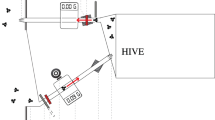Abstract
Tremble dances are sometimes performed by returning forager bees instead of waggle dances. Recent studies by Seeley (1992) and Kirchner (1993) have revealed that this behaviour is part of the recruitment communication system of bees. The ultimate cause of tremble dances is, according to Seeley (1992), an imbalance between the nectar intake rate and the nectar processing capacity of the colony. This imbalance is correlated with a long initial search time of returning foragers to find bees to unload them. However, it remained unclear whether a long search time is the direct proximate cause of tremble dancing. Here we report that a variety of experimental conditions can elicit tremble dances. All of them have in common that the total search time that foragers spend searching for unloaders, until they are fully unloaded, is prolonged. This finding supports and extends the hypothesis that a long search time is the proximate cause of tremble dancing. The results also confirm the previous reports of Lindauer (1948) and others about factors eliciting tremble dancing.
Similar content being viewed by others
References
Breed MD (1983) Nest mate recognition in honeybees. Anim Behav 31:86–91
Esch H (1964) Beiträge zum Problem der Entfernungsmessung in den Schwänzeltänzen der Honigbiene. Z vergl Physiol 48:534–546
Frisch K von (1923) Über die Sprache der Bienen - eine tierpsychologische Untersuchung. Zool Jb Physiol 40:1–186
Frisch K von (1967) The dance language and orientation of bees. Harvard University Press, Cambridge, MA
Kirchner WH (1993) Vibrational signals in the tremble dance of the honeybee, Apis mellifera. Behav Ecol Sociobiol 33:169–172
Kirchner WH, Gadagkar R (1994) Discrimination of nestmate workers and drones in honeybees. Insectes Soc 41:335–338
Lindauer M (1948) Über die Einwirkung von Duft- und Geschmacksstoffen sowie anderer Faktoren auf die Tänze der Bienen. Z vergl Physiol 31:348–412
Michelsen A, Kirchner WH, Lindauer M (1986) Sound and vibrational signals in the dance language of the honeybee, Apis mellifera. Behav Ecol Sociobiol 18:207–212
Moritz RFA, Hillesheim E (1990) Olfactory discrimination between group odors in honeybees: kin or nest mate recognition? Insectes Soc 37:90–99
Nieh JC (1993) The stop signal of honey bees: reconsidering its message. Behav Ecol Sociobiol 33:51–56
Schneider F (1949) Über die Vergiftung der Bienen mit Dinitrokresol. Mitt Schweiz Entomol Ges 22:293–308
Schick W (1953) Über die Wirkung von Giftstoffen auf die Tänze der Bienen. Z vergl Physiol 35:105–128
Seeley TD (1989) Social foraging by honey bees: how nectar foragers assess their colony's nutritional status. Behav Ecol Sociobiol 24:181–199
Seeley TD (1992) The tremble dance of the honey bee: message and meanings. Behav Ecol Sociobiol 31:375–383
Seeley TD, Tovey CA (1994) Why search time to find a food-storer bee accurately indicates the relative rates of nectar collecting and nectar processing in honey bee colonies. Anim Behav 47:311–316
Author information
Authors and Affiliations
Additional information
Communicated by R.F.A. Moritz
Rights and permissions
About this article
Cite this article
Kirchner, W.H., Lindauer, M. The causes of the tremble dance of the honeybee, Apis mellifera . Behav Ecol Sociobiol 35, 303–308 (1994). https://doi.org/10.1007/BF00184419
Received:
Accepted:
Issue Date:
DOI: https://doi.org/10.1007/BF00184419




